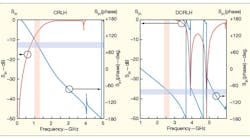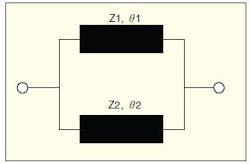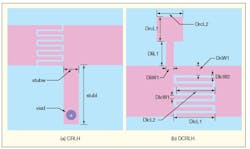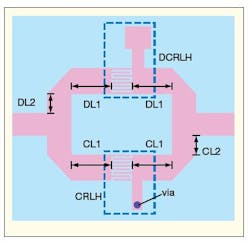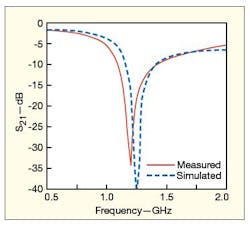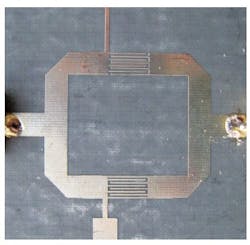CRLH, DCRLH Cells Create Novel Prototype
Signal-interference technology represents a departure in microwave circuit design. It has been applied to the fabrication of extremely small bandstop filters, not constrained by the geometries of quarter-wavelength lines. In this report, a signal-interference prototype circuit was fabricated with composite right/left-handed (CRLH) cells and dual CRLH (DCRLH) cells. The cells exhibit some unusual effects. For example, the distribution of right/left-handed passbands for the DCLRH cells is opposite that of the CLRH cells. The DCLRH cells also yield a slow-wave effect in the right-handed passband within the lower frequency band, which helps to miniaturize the design.
1. This simple structure shows the basic structure used to realize the signal-inteference effect at a given frequency.
Signal-interference techniques have been effective in realizing bandstop filters, although their operating principles are much different than those of conventional quarter-wavelength open-circuit stubs or defected-ground-structure (DGS) circuit approaches.1 The concept of signal interference in microwave engineering was initially proposed in ref. 2; a basic structure to realize signal interference is shown in Fig. 1. A signal that is divided and propagates through the two paths will cancel at the output end with the proper electrical relationships of the two paths. That special relationship can be found through theoretical analysis, and is expressed by Eq. 13
Z2sin(θ2)
+ Z1sin(θ1) = 0 (1)
where Z1 and Z2 are the characteristic impedances of the two transmission paths and θ1 and θ2 are the corresponding electrical lengths (in deg.).
When the conditions of Eq. 1 have been satisfied, the proposed signal-interference structure will yield one transmission zero, namely the bandstop property at the corresponding frequency point. For the simple case where Z1 = Z2, the fact that the difference between θ1 and θ2 is 180 deg. can satisfy Eq. 1. As a result, transmission-line paths with electrical lengths of 90 and 270 deg. or with electrical lengths of 180 and 360 deg. have been used in previous signal-interference prototype designs. The use of signal paths with electrical lengths of 270 or 360 deg. result in large physical dimensions, even when fabricated as meandered or fractal-geometry lines, so that the shorter electrical paths are of greater interest for designs that must be miniaturized at a given frequency.
To miniaturize a bandstop-filter signal-interference prototype based on CRLH and DCRLH cells, at the frequency of interest, a CRLH cell with +90-deg. phase shift within its left-handed passband replaced a conventional transmission-line path with −270-deg. phase shift. A DCRLH cell with −90-deg. phase shift within its lower right-handed passband substituted for a conventional transmission-line path with −90-deg. phase shift. Due to the slow-wave effect of the DCRLH cell within its lower right-handed passband, it also helps to miniaturize the prototype. To ensure that the signal-interference effect has been achieved, computer-aided-engineering (CAE) simulations on the prototype design will be performed and compared with results from a fabricated circuit.
The CRLH cell yields a left-handed passband in its lower-frequency band and a right-handed passband in its higher-frequency band. Because it can provide a leading phase shift within its left-handed passband, it has been of interest to circuit designers. A CRLH cell can be realized by means of lumped-element circuits,4 via the integration of a capacitive gap and a split-ring resonator,5 or through the integration of a digital capacitor and a shunt short-circuit stub.6
In this report, a CRLH cell was realized by means of the interdigital capacitor and the shunt short-circuit stub, with the chosen configuration shown in Fig. 2(a). The CRLH cell was used with a +90-deg. phase shift at the frequency of interest, replacing a conventional transmission line and its +270-deg. phase shift.
2. These diagrams represent the circuit configurations of the (a) CRLH cell and the (b) DCRLH cell.
A DCRLH cell is a dual version of a CRLH cell, with a right-handed passband in the lower frequency band and a left-handed passband in the higher-frequency band.7 Compared with work that has been done on CRLH cells, research on DCRLH cells is still in its formative stages. Several early realizations of DCRLH cells have been proposed.8-10 For this report, the microstrip version was chosen; its geometric structure is shown in Fig. 2(b).
A DCRLH cell is composed of one interdigital capacitor, one narrow microstrip line parallel to the capacitor, a rectangular patch, and a narrow shunt microstrip line. In the current design, the right-handed passband of the DCRLH cell was primarily examined, since its left-handed passband in the higher-frequency band is difficult to adjust around a given design frequency. Of course, the right-handed properties of a DCRLH cell is unlike the right-handed characteristics of a conventional microstrip transmission line. The differences can be found by comparing a conventional microstrip line and a DCRLH cell with identical physical lengths. This comparison is depicted in Fig. 3. The geometric parameters used in the simulation were as follows: DrcL1 = 5 mm; DliL1 = 4 mm; DliW1 = 1 mm; DriW1 = 0.3 mm; DlcL1 = 4.2 mm; DlcL2 = DlcL1 – 0.2 mm, and DlcW2 = DlcW1 are kept constant throughout. The width of the microstrip line is 4.6 mm. A printed-circuit-board (PCB) substrate with relative dielectric constant of 2.2 and thickness of 1.5 mm was used to fabricate the prototype.
Figure 3 shows that, for the same discrete frequency, the phase shift of the DCRLH cell is larger than that for the microstrip line, indicating that the DCLRH cell exhibits slow-wave characteristics within its right-handed passband. In addition, the phase differences between the CLRH and DCLRH cells increases as frequency increases. A −90-deg. phase shift is relatively easy to achieve with the right-handed passband of the DCLRH cell.
3. This plot of phase versus frequency compares the response of a DCRLH cell to a standard microstrip line of equivalent length.
Based on these observations, a signal-interference prototype circuit based on CRLH and DCRLH cells was designed (Fig. 4). The width of the interdigital capacitor in the CRLH cell and the width of the interdigital capacitor (including the narrow parallel line) in the DCRLH cell are equal, both 4.6 mm, which is also the width of the 50-Ω microstrip line. The value and lengths of the interdigital capacitors are equal for both the CRLH and DCRLH cells. The performance of the capacitors was controlled by adjusting their shunt sections. In the initial design, it was thought that the CRLH cell with +90-deg. phase shift would function as the path with the −270-deg. phase shift, while the DCRLH cell with the −90-deg. phase shift would be the other signal path.
4. This is the circuit configuration for the proposed signal-interference design.
Now it was necessary to implement the design. In the first step, the CRLH and DCRLH cells were adjusted individually. For simplicity, the frequency point with −90-deg. phase shift for the DCRLH was first set at 1.30 GHz. The geometric parameters corresponding to this condition are as follows: DrcL1 = 5 mm; DliL1 = 4 mm; DliW1 = 2.5 mm; DriW1 = 0.3 mm; DlcW1 = 0.3 mm; DlcL1 = 4.0 mm; and DlcL2 = DlcL1 – 0.2 mm. Next, the performance of the CRLH cell was adjusted to achieve a +90-deg. phase shift at 1.45 GHz, primarily by modifying the shunt path parameters, stubl and stubw, as shown in Fig. 2(a). Through optimization, these parameters are chosen to be stubl = 11.2 mm and stubw = 1.2 mm. Figure 5 shows the results of individual adjustments for the CRLH and DCRLH cells.
5. These plots of forward transmission versus frequency show the effects of adjustments made on the CRLH cell (left) and the DCRLH cell (right).
As shown in Fig. 5, the design goals were achieved effectively. In the second step, the synthesized design was implemented. There is some electromagnetic (EM) coupling between the two cells, which will impact performance. Knowing that, parameters DL1, DL2, CL1, and CL2 were optimized. Following optimization, they were set at the following values: DL1 = 8.2 mm; DL2 = 7.6 mm; CL1 = 8.2 mm; and CL2 = 7.6 mm. The signal-interference circuit was then fabricated and measurements were performed with a commercial microwave vector network analyzer (VNA). The simulated and measured results are shown in Fig. 6, and a photograph of the signal-interference prototype circuit is shown in Fig. 7.
6. These plots compare the computer-simulated performance and the actual measured performance of the fabricated signal-interference design.
7. This photograph shows the prototype signal-interference design fabricated with CRLH and DCRLH cells.
According to the results shown in Fig. 6, the prototype circuit exhibited a sharp bandstop characteristic around 1.25 GHz, indicating that the signal-interference effect has been achieved. The center frequency of the stop band, 1.25 GHz, is lower than the target design goal, 1.30 GHz, for the individual design stage. This may be caused by EM coupling. Still, based on these results, it is reasonable to assume that the design method detailed in this report is valid and effective. The prototype circuit, which did not include a conventional microstrip line with −270-deg. phase shift, was fabricated in a much smaller size than conventionally possible.
In summary, it was possible to design a miniature signal-interference prototype with bandstop characteristics by using the phase-leading properties of a CRLH cell within its left-handed passband and the slow-wave effect of a DCRLH cell within its right-handed passband. At the target design frequency, the CRLH cell, with its +90-deg. phase shift, was used to replace the signal path with −270-deg. phase shift in a basic signal-interference model. The DCRLH, with its-90-deg. phase shift, functioned as the other path.
Tong Xu, Researcher
Ke Lu, Researcher
Bin-Feng Zong, Researcher
Bao-Jun Song, Researcher
Missile Institute, Air Force Engineering University, Sanyuan 713800, People’s Republic of China, e-mail: [email protected].
Acknowledgments
This work is supported by the National Natural Science Foundation of China under Grant No. 60971118. The authors would also like to thank the China North Electronic Engineering Research Institute.
References
1. T.-K.L. Duk-Jae Woo, Jae-Wook Lee, Cheol-Sig Pyo, and Won-Kyu Choi, “Novel U-Slot and V-Slot DGSs for Bandstop Filter With Improved Q Factor,” IEEE Transactions on Microwave Theory & Techniques, Vol. 54, No. 6, 2006, pp. 2840-2847.
2. M.K. Mandal, “Compact bandstop filter using signal interference technique,” Electronics Letters, Vol. 43, No. 2, 2007, p. 18.
3. M.K. Mandal, “Design of sharp-rejection, compact, wideband, bandstop filters,” IET Microwaves, Antennas & Propagation, Vol. 2, No. 4, 2008, pp. 389-393.
4. Jian An, “Diplexer Using Composite Right/Left-Handed Transmission Line,” Electronic Letters, Vol. 44, No. 11, 2008, pp. 22.
5. M. Mil, I. Gil, J. Garci a-Garci, and F. Martini, “On the transmission properties of left-handed microstrip lines implemented by complementary split rings resonators,” International Journal of Numerical Modelling: Electric Networks, Devices, and Fields, Vol. 19, 2006, pp. 87-103.
6. A. Sanada and T. Itoh, “Characteristics of the composite right/left-handed transmission lines,” IEEE Microwave and Wireless Component Letters, Vol. 14, No. 2, 2004, pp. 68-70.
7. C. Caloz, “Dual composite right/left-handed (D-CRLH) transmission line metamaterial,” IEEE Microwave and Wireless Component Letters, Vol. 16, No. 11, 2006, pp. 585-687.
8. V. Gonzalez-Posadas, A. Parra-Cerrada, L.E. Garcia-Munoz, and D. Segovia-Vargas, “Dual-composite, right-left-handed transmission lines for the design of compact diplexers,” IET Microwaves, Antennas & Propagation, Vol. 4, No. 8, 2010, pp. 982-990.
9. C. Caloz, “Novel broadband conventional and dual-composite right/left-handed (C/D-CRLH) metamaterials: Properties, implementation, and double-band coupler application,” Applied Physics A: Materials Science & Processing, Vol. 87, 2007, pp. 309-316.
10. Changjun Liu, “A Microstrip Diplexer from Metamaterial Transmission Lines,” Proceedings of the 2009 IEEE International Microwave Symposium (IMS), pp. 65-68.
